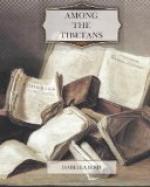Just outside the Commissioner’s grounds are two very humble whitewashed dwellings, with small gardens brilliant with European flowers; and in these the two Moravian missionaries, the only permanent European residents in Leh, were living, Mr. Redslob and Dr. Karl Marx, with their wives. Dr. Marx was at his gate to welcome me.
To these two men, especially the former, I owe a debt of gratitude which in no shape, not even by the hearty acknowledgment of it, can ever be repaid, for they died within a few days of each other, of an epidemic, last year, Dr. Marx and a new-born son being buried in one grave. For twenty-five years Mr. Redslob, a man of noble physique and intellect, a scholar and linguist, an expert botanist and an admirable artist, devoted himself to the welfare of the Tibetans, and though his great aim was to Christianize them, he gained their confidence so thoroughly by his virtues, kindness, profound Tibetan scholarship, and manliness, that he was loved and welcomed everywhere, and is now mourned for as the best and truest friend the people ever had.
I had scarcely finished breakfast when he called; a man of great height and strong voice, with a cheery manner, a face beaming with kindness, and speaking excellent English. Leh was the goal of my journey, but Mr. Redslob came with a proposal to escort me over the great passes to the northward for a three weeks’ journey to Nubra, a district formed of the combined valleys of the Shayok and Nubra rivers, tributaries of the Indus, and abounding in interest. Of course I at once accepted an offer so full of advantages, and the performance was better even than the promise.
Two days were occupied in making preparations, but afterwards I spent a fortnight in my tent at Leh, a city by no means to be passed over without remark, for, though it and the region of which it is the capital are very remote from the thoughts of most readers, it is one of the centres of Central Asian commerce. There all traders from India, Kashmir, and Afghanistan must halt for animals and supplies on their way to Yarkand and Khotan, and there also merchants from the mysterious city of Lhassa do a great business in brick tea and in Lhassa wares, chiefly ecclesiastical.
The situation of Leh is a grand one, the great Kailas range, with its glaciers and snowfields, rising just behind it to the north, its passes alone reaching an altitude of nearly 18,000 feet; while to the south, across a gravelly descent and the Indus Valley, rise great red ranges dominated by snow-peaks exceeding 21,000 feet in altitude. The centre of Leh is a wide bazaar, where much polo is played in the afternoons; and above this the irregular, flat-roofed, many-balconied houses of the town cluster round the palace and a gigantic chod-ten alongside it. The rugged crest of the rock on a spur of which the palace stands is crowned by the fantastic buildings of an ancient gonpo. Beyond the crops and plantations which surround the




